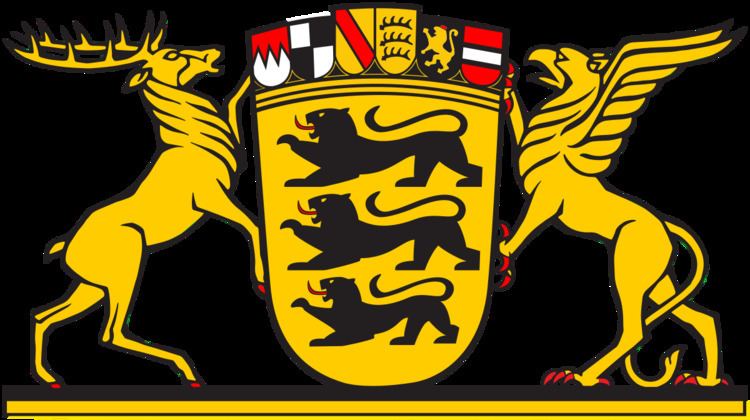Adopted 1954 | ||
 | ||
Crest Six escutcheons of Franconia, Hohenzollern, Baden, Württemberg, Electorate of the Palatinate and Further Austria Compartment A pedestal sable and or | ||
The coat of arms of the German state of Baden-Württemberg features a greater and a lesser version.
Contents
History
The coat of arms of Baden-Württemberg was determined after the merging of the former German states Baden, Württemberg-Baden and Württemberg-Hohenzollern, that were divided due to different occupying forces after World War II, in 1952. The creation of the state was not without controversies and thus only the state colours black and gold were determined in 1952, but not yet the arms. The latter were only regulated in the Gesetz über das Wappen des Landes Baden-Württemberg (Law on the Coat of Arms of Baden-Württemberg) of 3 May 1954. Its use is moreover regulated by an order dated 2 August 1954. It was designed by Fritz Reinhardt.
On base of article 24 clause 2 of the constitution, on April 28. 1954, the parliament has decided the following law, which is hereby proclaimed:
- The coat of arms of the state of Baden-Wuerttemberg shows in a golden shield three pacing black lions with red tongues. It is used as the greater and the smaller coat of arms.
- In the greater coat of arms of the state, on the shield rests a crown with badges of the historical coats of arms of Badenia, Wuerttemberg, Hohenzollern, Palatinate, Franconia and Further Austria. The shield is held by a golden deer and a golden griffon, which are armored in red.
- At the smaller coat of arms of the state, on the shield rests a crown of leaves (people's crown).
The shield shows three black lions with red tongues on a golden background. The arms refer to the coat of arms of the Duke of Swabia whose House of Hohenstaufen had used these arms. The name of Suabia had long been discussed for use with the newly created state but it failed to be adopted due to resistance from parts of Baden.
Greater coat of arms
The six small coat of arms at the top stand for the origins of parts of Baden-Württemberg. They are from left to right:
Thereby the arms of Baden and Württemberg are slightly elevated. The supporters are a stag to the left representing Württemberg and a griffin to the right representing Baden. The supporters were the charges in the arms of the pre-war states of Baden and Württemberg. They are positioned on a pedestal of black and gold which is not further mentioned in the law about the arms.
The great coat of arms is only used by higher authorities, i.e. the state premier, the government, the ministries, the state's representation to the Federation and to the EU, the Supreme State Court and higher courts, the audit court and the Administrative Districts.
Lesser arms
The lesser coat of arms features the shield topped with crown styled like leaves that symbolises the people's sovereignty after the abolishment of monarchy in Germany. The lesser arms are used by all state authorities that do not employ the great coat of arms, as well as by those notaries that are civil servants.
